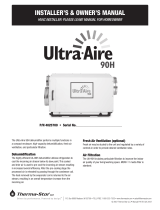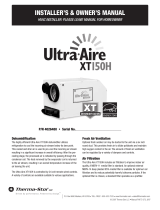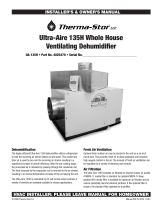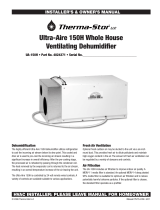©2007 RESEARCH PRODUCTS CORPORATION
P.O. BOX 1467 • MADISON, WI 53701-1467 • PHONE: 800/334-6011 • FAX: 608/257-4357 • www.aprilairecontractor.com
10007236 10.07
B2203961C
LIMITED WARRANTY
Your Research Products Corporation Aprilaire
®
Dehumidifier is expressly warranted for five (5) years from date of installation to be free from defects in
materials or workmanship.
Research Products Corporation’s exclusive obligation under this warranty shall be to supply, without charge, a replacement for any component which is found
to be defective within such five (5) year period and which is returned not later than thirty (30) days after said five (5) year period by you to either your original
supplier or to Research Products Corporation, Madison, Wisconsin 53701, together with the model number and installation date of the dehumidifier.
THIS WARRANTY SHALL NOT OBLIGATE RESEARCH PRODUCTS CORPORATION FOR ANY LABOR COSTS AND SHALL NOT APPLY TO DEFECTS IN
WORKMANSHIP OR MATERIALS FURNISHED BY YOUR INSTALLER AS CONTRASTED TO DEFECTS IN THE DEHUMIDIFIER ITSELF.
IMPLIED WARRANTIES OF MERCHANTABILITY OR FITNESS FOR A PARTICULAR PURPOSE SHALL BE LIMITED IN DURATION TO THE AFORESAID FIVE YEAR
PERIOD. RESEARCH PRODUCTS CORPORATION’S LIABILITY FOR INCIDENTAL OR CONSEQUENTIAL DAMAGES, OTHER THAN DAMAGES FOR PERSONAL
INJURIES, RESULTING FROM ANY BREACH OF THE AFORESAID IMPLIED WARRANTIES OR THE ABOVE LIMITED WARRANTY IS EXPRESSLY EXCLUDED. THIS
LIMITED WARRANTY IS VOID IF DEFECT(S) RESULT FROM FAILURE TO HAVE THIS UNIT INSTALLED BY A QUALIFIED HEATING AND AIR CONDITIONING
CONTRACTOR. IF THE LIMITED WARRANTY IS VOID DUE TO FAILURE TO USE A QUALIFIED CONTRACTOR, ALL DISCLAIMERS OF IMPLIED WARRANTIES SHALL
BE EFFECTIVE UPON INSTALLATION.
Some states do not allow limitations on how long an implied warranty lasts or the exclusion or limitation of incidental or consequential damages so the above
exclusion or limitations may not apply to you.
This warranty gives you specific legal rights and you may also have other rights which vary from state to state.
VENTILATION OR FAN CYCLING SEQUENCE OF OPERATION
If the dehumidifier is providing outdoor air ventilation or fan cycling, it is monitoring the HVAC equipment to provide the amount
of HVAC fan run time that has been set by the Cycle Time during the Cycle Period.
If an outdoor air damper has not been installed then the dehumidifier is providing fan cycling. The dehumidifier will monitor the
HVAC system and if the system has not run for the specified Cycle Time within the Cycle Period, the dehumidifier will energize
the HVAC fan through the G terminal to provide the desired amount of fan run time.
For example, if the Cycle Time is set for 10 minutes and the Cycle Period is set for 1 hour then the dehumidifier will provide
10 minutes of fan cycling or outdoor air ventilation. If the HVAC system runs for 5 minutes during this hour then the dehumidifier
will energize the fan for an additional 5 minutes.
If an outdoor air damper has been installed, then the Model 1720 is providing outdoor air ventilation. The 1720 will open the
outdoor air damper whenever the HVAC system is running, up to the amount of time specified by the Cycle Time. The
dehumidifier will energize the HVAC fan and open the outdoor air damper to provide the desired ventilation time if the HVAC
system has not run for the specified Cycle Time. During ventilation, the dehumidifier blower will operate and the unit will
dehumidify if necessary.
If an Outdoor Temperature Sensor has been installed, then the dehumidifier will use the outdoor temperature to determine if the
outdoor air damper is to be opened. If the outdoor temperature is above 100°F the damper will not open. If the temperature is
between 20°F and 0°F the damper will only open with a heat call. If the outdoor temperature is below 0°F, the damper will not
open. If the Outdoor Temperature Sensor is not installed then the temperature is not considered in opening the damper.
Your Warranty Registration information will not be sold or shared outside of this company.
Thank you!
WARRANTY REGISTRATION
Please… Take a few minutes to visit us on-line at www.aprilaire.com to register your Aprilaire product.
If you do not have on-line access, please mail a postcard with your name, address, phone number, product purchased and date of purchase to:
Research Products Corporation
P.O. BOX 1467
Madison, WI 53701




















